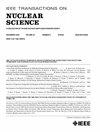Effects of the Distribution of Secondary-Phase and Deep-Level Defects on the Performance of CdZnTe Nuclear Radiation Detectors
IF 1.9
3区 工程技术
Q3 ENGINEERING, ELECTRICAL & ELECTRONIC
引用次数: 0
Abstract
The susceptibility of CdZnTe (CZT) crystals to complex defects during the growth process poses significant challenges in preparing probe-grade CZT single crystals, thereby constraining their extensive application in nuclear radiation detectors. To deeply understand the influence of defects on the performance of CZT crystals, this study systematically investigates the influence of the secondary-phase and related deep-level defect distribution on the photoelectric performance of CZT crystals grown by the vertical gradient freeze (VGF) method. It was found that the crystals with low density of secondary-phase defects and a small defect size have a larger bulk resistivity of二次相和深能级缺陷分布对CdZnTe核辐射探测器性能的影响
CdZnTe (CZT)晶体在生长过程中对复杂缺陷的敏感性给制备探针级CZT单晶带来了重大挑战,从而限制了其在核探测器中的广泛应用。为了深入了解缺陷对CZT晶体性能的影响,本研究系统研究了二次相及相关深层缺陷分布对垂直梯度冻结(VGF)法生长的CZT晶体光电性能的影响。结果表明,二次相缺陷密度小、缺陷尺寸小的晶体具有较大的体积电阻率$5.13\ × 10^{10}~\Omega ~\cdot $ cm,霍尔迁移率$ 330 cm ${}^{-1}~\cdot $ s−1,载流子迁移率-寿命积$1.38\ × 10^{-3}$ cm ${}^{2}~\cdot $ V−1。当前的深能级瞬态光谱(i - dts)结果表明,大尺寸和高密度的二次相缺陷分别导致了深能级陷阱捕获截面的增加和缺陷浓度的升高。在载流子输运过程中,二次相、Tei和[TeCd]2+相关的深能级缺陷表现出较长的电荷脱陷时间,导致载流子浓度下降和电荷收集不完全。基于能带理论,我们阐明了CZT晶体中缺陷相互作用的机制。该研究为后续通过晶体生长过程实现缺陷的有效调制提供了基础。
本文章由计算机程序翻译,如有差异,请以英文原文为准。
求助全文
约1分钟内获得全文
求助全文
来源期刊

IEEE Transactions on Nuclear Science
工程技术-工程:电子与电气
CiteScore
3.70
自引率
27.80%
发文量
314
审稿时长
6.2 months
期刊介绍:
The IEEE Transactions on Nuclear Science is a publication of the IEEE Nuclear and Plasma Sciences Society. It is viewed as the primary source of technical information in many of the areas it covers. As judged by JCR impact factor, TNS consistently ranks in the top five journals in the category of Nuclear Science & Technology. It has one of the higher immediacy indices, indicating that the information it publishes is viewed as timely, and has a relatively long citation half-life, indicating that the published information also is viewed as valuable for a number of years.
The IEEE Transactions on Nuclear Science is published bimonthly. Its scope includes all aspects of the theory and application of nuclear science and engineering. It focuses on instrumentation for the detection and measurement of ionizing radiation; particle accelerators and their controls; nuclear medicine and its application; effects of radiation on materials, components, and systems; reactor instrumentation and controls; and measurement of radiation in space.
 求助内容:
求助内容: 应助结果提醒方式:
应助结果提醒方式:


